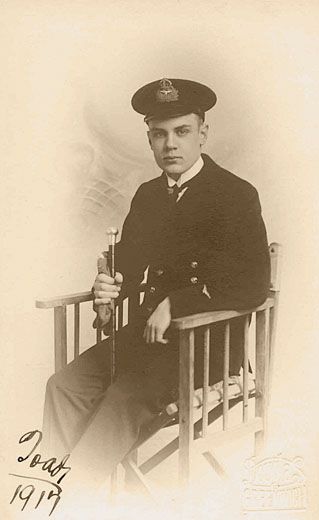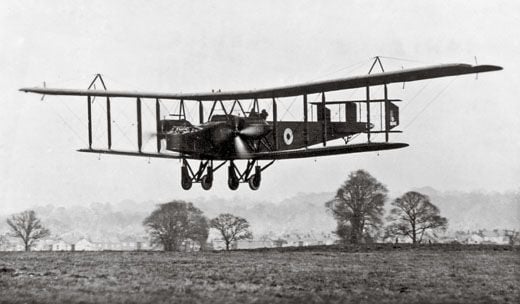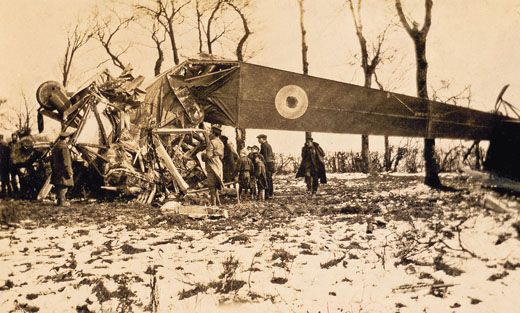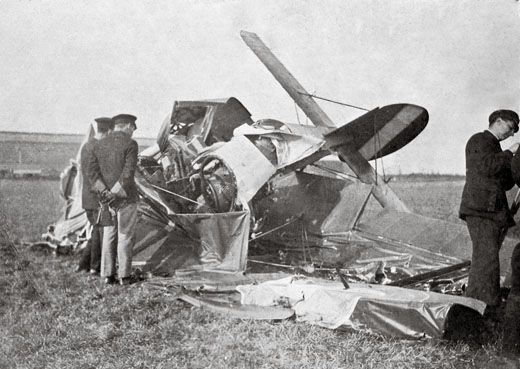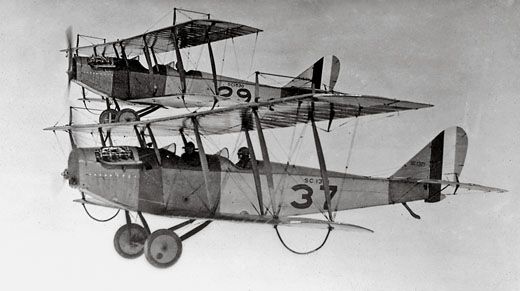The Few, the Brave, the Lucky
To face the enemy in World War I, pilots first had to survive flight training.
/https://tf-cmsv2-smithsonianmag-media.s3.amazonaws.com/filer/ww1-training-631.jpg)
Dear Mother and Dad:
This looks cheerful, but it is much more cheerful than it looks…. After 12 hours on BE2c’s I took one up and smashed it to bits. Am not hurt—just messed up a bit.
—Letter home, March 16, 1918
Frederic Barr Shaw had reason to be cheerful. He was alive, and would fly again, unlike scores of fellow cadets in Britain’s Royal Air Force. The year before, Shaw had recorded in his journal that at the field where he received primary flight training, there were an average of three crashes a day. In most cases, the pilot escaped with only cuts and bruises, but over the course of several months, many were seriously injured or killed.
During most of World War I, pilots stood a greater chance of being killed during training or in accidents than in combat. Aviation, after all, was only a few years old when the war broke out in 1914. From a few dozen types of airplanes and a few hundred pilots around the world, it grew in a matter of years to include hundreds of types of aircraft and thousands of pilots. In 1917, British manufacturers rolled out nearly 14,000 aircraft—a staggering number, considering that just three years earlier, only 193 had been built in the course of a year. With hostilities at full bore, the pressure to produce airplanes and pilots for combat resulted in unreliable machines flown by men who didn’t know how to operate them. Training time was slashed from six months to three in order to double the number of pilots for the Royal Flying Corps and the Royal Naval Air Service (they merged in 1918 to become the Royal Air Force). In the letters and diaries of pilots like Shaw, the process of training emerges as a raw and dangerous business.
A terrible day. Harold Coo, Langston and Lt. Cdr. Murray were killed. Chesterton had two legs broken and MacLaren concussion of the brain. Many crashes. Coo and Langston collided at 500 ft. Murray and Chesterton in dual flight came to earth in a spinning nose dive... Getting awfully fed up on the flying game. Feeling blue.
—Shaw’s journal, January 22, 1918
Shaw considered himself the ideal candidate for the Royal Naval Air Service, even though he had likely never seen an airplane, much less flown in one. Born in Canada, he was living in Kansas City, Missouri, when he volunteered to become a cadet, figuring his year of college and classical piano training would impress recruiters looking for good breeding and social standing. After several months of letters and telegrams to a recruiter in Ottawa, Shaw was finally accepted, and in October 1917 he was told to go to Halifax and catch a boat bound for England. He was assigned to Squad 16-A, along with about 40 other recruits, at the Royal Naval College in Greenwich. There, his month-long training consisted of lectures on flight theory, meteorology, navigation, wireless telegraphy, and engine mechanics. The courses, he wrote his parents, were terribly boring and seemed to have little to do with flying. “Rotten, all of them,” he complained in a letter home. Shaw was then transferred to Vendome, a small French town about 120 miles southwest of Paris, to begin flight training.
The first flight with an instructor piloting is called the “joy flip”—I believe they side-slip, nose spin and generally try to scare you green. I am looking forward to it.
—Letter home, November 9, 1917
About the same time Shaw arrived in Europe, John McGavock Grider was transferred from the U.S. military air service to the Royal Flying Corps. Grider was a divorced cotton farmer from Arkansas with two young sons and a taste for adventure. Like Shaw, he wrote about his training and the catastrophes he witnessed at British flight schools. Together, their accounts draw a vivid picture of the risks that men of their time took to become military pilots.
A horrible thing happened today. We were all out on the tarmac having our pictures taken for posterity when somebody yelled and pointed up. Two Avros collided right over the airdrome at about three hundred feet. God, it was a horrible sight. We didn’t know who was in either one of them. I was glad I was sitting next to Cal. They came down in a slow spin with their wings locked together and both of them in flames. Fred Stillman was in one machine and got out alive but badly burned and Doug Ellis was in the other one and was burned to a cinder.
—Diary of John M. Grider, February 9, 1918, as edited and amended by friend and fellow pilot Elliot White Springs, in The War Birds—Diary of an Unknown Aviator, Texas A&M University Press, 1988
Two weeks later, Grider wrote about another disaster, this one apparently caused by the simplest of mistakes: failure to wear a safety belt.
Montgomery was killed when the pilot fell out of the front seat in an [Avro] in a loop. Montgomery was in the back seat and crawled up into the front cockpit and just had his hands on the controls when it crashed. Think of watching the ground coming up at you for two or three minutes while you wiggle up the fuselage. Makes my blood run cold!
It took one of the largest battles of World War I—and, with more than one million casualties, one of the bloodiest in history—to begin changing the face of military aviation, including better training for pilots. The Battle of the Somme, fought from July to November 1916, cost Britain a total of 782 airplanes and 576 pilots. While it was safer to be a pilot than a soldier in the trenches (the battle killed 420,000 British ground troops), concern over the adequacy of training forced Britain to establish minimum requirements for new pilots: 15 hours of solo flying, a cross-country flight of 60 miles with two landings, a climb to 6,000 feet with 15 minutes of flying level, a dead-stick landing within a circle 50 yards in diameter, and two landings in darkness, assisted by flares.
By 1917, every pilot was required to perform aerobatics: to sideslip, to loop, to imitate a fall out of control, and to perform a dozen other maneuvers. Though most training airplanes were outfitted with dual controls, allowing the student to learn by first following the instructor’s control movements, many instructors knew only marginally more than their students. Instructors were simply drawn from pilots either waiting to go to the front or those deemed unfit for it. There was no consideration given to their qualifications or motivation, and they received little supervision. Each instructor taught on the basis of his own experience and attitude. Many instructors, though, were averse to taking risks themselves, so they taught their students primarily how to avoid getting into dangerous flight situations, rather than how to recover from them. As a result, training left the students ill-equipped to deal with the challenges of aerial combat. According to The Great War in the Air by John H. Morrow, one British officer complained in May 1917 that most pilots being sent into combat “can’t even fly, let alone fight.”
Experienced pilots understood that if they manipulated the controls in a particular way, the aircraft would—or at least should—move in a certain way. Yet few could explain exactly why, or which flight controls performed at each stage of a maneuver. Many principles of flight were simply a mystery, so if anything unexpected happened, a pilot was apt to lose control, and his ability to regain it was often a matter of luck.
Take spins: Before 1916, few pilots unfortunate enough to get themselves into a spin lived to tell of the experience. One pilot who did was surrounded upon landing by others congratulating him on his seemingly fantastic feat. When asked how he did it, he cheerfully replied that he did “everything wrong,” by which he meant he did the opposite of what his experience and intuition as a pilot told him. By mid-1917, enough anecdotes had circulated about pilots recovering from a spinning nose dive by pushing forward on the control stick rather than the natural inclination to pull back that it motivated British commanders to rethink air training. Under the leadership and inspiration of Major Robert Smith-Barry, the School of Special Flying was opened in Gosport, England, in August 1917.
Before Gosport, many pilots completed training while on active service, during which they were expected to fly more powerful, less forgiving aircraft, often with little or no training on transitioning from one type to another (by 1916, the British flew 76 varieties). They had to perform combat maneuvers while under fire and extreme stress. Gosport emphasized aerobatic and combat maneuvers and also adopted a standard aircraft for training: the British-made Avro 504 biplane. By the end of 1917, Smith-Barry also had introduced the Gosport Tube, a system of voice pipes and headphones for communication between instructor and pupil. Though it came too late in the war to benefit many pilots, Gosport revolutionized flight training in Britain, and according to Richard Hawkins in The Irish Sword, a journal of military history, many of the school’s techniques became part of the foundation of knowledge for generations of pilots.
Shaw did not have the benefit of the Gosport Tube for his first “flip,” as he and his comrades called a flight. After a week of sitting around Vendome watching crash after crash, he finally got in the air, taking off on Sunday, December 16, 1917, with his instructor in a French-made Caudron G-3 biplane. Sitting in the front seat of the two-seat trainer, Shaw stayed up for 35 minutes and got to a height of 200 feet. At one point, the instructor tapped him on the back and, using a hand signal, instructed him to take the control stick and perform a series of turns. Afterward, the instructor took control and landed the aircraft.
If there was anything remarkable about Shaw’s first flight, it was how unremarkable it was. In his letters and journal, there was no romantic reflection on having “slipped the surly bonds of Earth.” Despite all the waiting and all the crashes he had witnessed, he expressed no pent-up anxiety, no sense of anticipation, and no wonder at seeing the ground from a new perspective. For Shaw, as for many pilots then, it was all very matter-of-fact.
“If you were a kid and you got into one of these planes, you wouldn’t know how scared you should be because you had nothing to compare it to,” says Dan Taylor, a radio personality at WCBS-New York and a pilot, restorer, and historian. They would have had good reason to be nervous, says Taylor, who has flown everything from a 1911 Blériot to a 1917 Sopwith Camel. In World War I, he adds, “all these planes had a lot of drag, so they weren’t very aerodynamic. They had the glide ratio of a brick, so you always had to keep an eye out for an open field.”
Today, it takes years to design and test a new airplane before it goes into production. But in World War I, airplanes were designed, built, and flown in weeks, with the aerodynamics, flight characteristics, and structural integrity worked out literally on the fly. They were rickety machines, each little more than a wicker seat and an engine, held together with fabric and wire. Even in the best flying conditions, the aircraft were slow and unstable, requiring constant attention.
There was no such thing as “hands off” flying, Taylor explains. “The planes got pushed around by the wind, and the controls on many were heavy. You had to manage the engine much more, and you had to watch your attitude and airspeed to prevent overstressing the airframe.” And every airplane was different, even those of the same type. “They each had their own flight characteristics, depending on the individual rigging and what kind of damage the plane had sustained,” he says. Another worry was engine failure, so dead-stick landings were a required part of training. “But it did make you a better pilot, because you were more prepared for the unexpected,” Taylor says.
That is, if you survived. Before accumulating five hours of flying time, Shaw had wrecked two airplanes, a number that presumably was not considered a problem, given that his instructors allowed him to continue. After three and a half hours of flying with an instructor, Shaw soloed. He flew two circuits around the school’s field and landed, as he’d been instructed. Over the next three weeks, Shaw accumulated a total of 14 hours of dual and solo time, flying both Caudron and U.S.-made Curtiss JN “Jenny” trainers. In addition to takeoffs and landings, he mastered spirals and S-turns, climbed to 7,800 feet, and made a series of cross-country flights. He was then sent to Cranwell, England, for final training before being assigned to a combat squadron.
When he took off on March 11, 1918, from Cranwell’s field in a single-engine BE2c biplane, Shaw had a total of 25 hours of flight time. Soon after, he wrote, the engine “went dud,” just as it had many times before. At about 50 feet off the ground and with a large hangar and a line of airplanes looming in front of him, all his options were bad. Deciding not to crash into the hangar and the airplanes, he tried to turn around. He
didn’t make it. The airplane stalled and nosed into the ground. Shaw was pried bleeding and unconscious from the twisted mass of wood, wire, and cloth. When he came to, he was in the Northern General Hospital in Lincoln, where he was told details of the crash.
His injuries were minor: a concussion and some cuts and bruises. But he would spend nearly eight weeks at the hospital, apparently lost in the bureaucracy as the new Royal Air Force began operations. When he finally returned to Cranwell, it was June, and he had to repeat much of his earlier training.
Grider, in the meantime, had also survived flight training, accumulating about 20 solo hours before being sent to the School of Aerial Fighting in Ayr, Scotland. There, he advanced from Farmans to French SPADs, and saw nine cadets die in crashes. He was at Ayr just 19 days when he was ordered to the front. “I’d like to stay here a while,” he wrote, “but they kill off pilots too fast for any one to linger very long.”
Assigned to the 85th Squadron under Canadian air ace Lieutenant Colonel William “Billy” Bishop, Grider flew bomber escort and patrols, helping to neutralize Germany’s new Fokker D.VII. He downed four enemy airplanes before disappearing in a fog behind enemy lines in June 1918. His squadron learned later from a note dropped by a German pilot that Grider had been shot down in a dogfight and was buried somewhere in Armentieres, France. The airfield in Pine Bluff, Arkansas, is dedicated to him.
As for Shaw, after completing his training at Cranwell, learning on BE2cs and Airco DH9s, he was sent to the #1 School of Navigation and Bomb Dropping at Stonehenge. There he learned how to fly the giant Handley Page O-400 twin-engine bomber, and how to conduct night bombing missions. By the time he finished the six-week course and was assigned to 100 Squadron in France, it was the last week of October 1918. Within two weeks, the Armistice was signed and the guns fell silent. Eight months later, Shaw returned to the United States without ever having flown a combat mission. While surviving flight training was lucky in itself, his crash was even luckier: Being out of commission for eight weeks may have saved his life. Back home in Missouri, he married his sweetheart, Dorothy Price, and the two had a daughter, Janet—my mother. His good luck, it turns out, was mine too.
